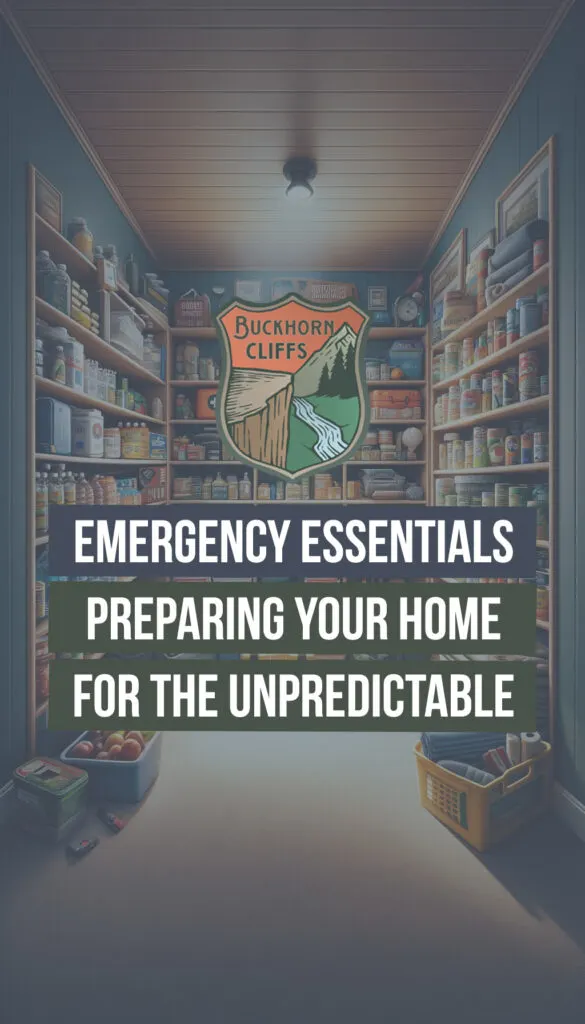Today’s unpredictable circumstances highlight the importance of preparing your home for a variety of situations, including power outages and local disruptions. The concept of home safety is evolving, encouraging a more rounded approach that goes beyond traditional security measures. This blog post aims to share practical steps to enhance your home’s readiness for unforeseen events, focusing on self-sufficiency, communication, and community connections.

Key steps include setting up systems to maintain essential functions during power outages, such as alternative energy sources and emergency supplies. It’s also wise to consider reinforcing your home against potential threats and establishing backup communication methods. Engaging with your community for support and shared strategies can further strengthen your preparedness. These tips are intended to offer guidance on creating a safer and more prepared home environment amidst uncertainty.
Also consider checking out:
- Self Managed Insurance Plan (start here)
- Product Recommendations (Survival, Prepping, Camping, Homesteading)
- Assemble Your Ultimate Fix-All Unconventional Essentials Kit
- Societal Breakdown (Stock These Items)
What’s covered in this post:
- Energy Independence and Backups
- Water and Food Security
- Communication Alternatives
- Home Security Enhancements
- Self-Defense
- Community Networks
- Emergency Planning and Drills
- Information and Documentation
Energy Independence and Backups
To keep your home powered and safe during outages, consider energy independence solutions like solar panels with battery storage, portable generators, and solar-powered chargers. These strategies ensure essential services—lighting, cooling, and communication—remain operational, minimizing reliance on the grid and enhancing preparedness for emergencies.
Solar Panels and Battery Storage
- What they do: Provide power during outages by converting sunlight into electricity, stored in batteries for later use.
- Benefits: Reduces reliance on the grid and ensures essential functions continue (lighting, cooling, communication).
- Considerations: Initial investment in panels and batteries required.
Portable Generators
- What they do: Offer immediate backup power for essential appliances.
- Safety tips:
- Operate outdoors to avoid carbon monoxide poisoning.
- Ensure proper ventilation away from windows and doors.
- Regular maintenance is crucial.
Solar-Powered Chargers
- What they do: Charge small devices like phones and radios using sunlight.
- Benefits: Keeps communication devices running during prolonged outages.
- Usage: Ideal for emergencies to maintain contact and access information.
Propane-Powered Generators
- What they do: Provide a reliable power source for essential appliances and lighting during outages.
- Benefits: Reduces reliance on the electrical grid, ensuring essential functions continue.
- Considerations: Requires a sufficient propane supply and understanding of generator capacity to meet your needs.
Propane Heaters
- What they do: Offer a dependable heating solution when electricity is unavailable.
- Benefits: Keeps living spaces warm without the need for electric heating.
- Considerations: Necessitates proper ventilation to prevent carbon monoxide poisoning and adherence to safety guidelines.
Propane Cooking Appliances
- What they do: Allow for the preparation of meals without electricity.
- Benefits: Ensures the ability to cook and boil water during power outages.
- Considerations: Portable propane tanks need safe storage, and users must be familiar with operating these appliances safely.
Propane Storage and Safety
- What it involves: Safe keeping of propane tanks and ensuring an adequate supply.
- Benefits: Maintains a ready energy source for generators, heaters, and cooking appliances.
- Considerations: Propane tanks should be stored outdoors in a ventilated area, away from potential hazards, with attention to supply levels for sustained emergency use.
For more propane insights: Propane Tools for Emergency Scenarios
These strategies provide a layered approach to energy backup, ensuring your home stays powered and functional during outages.
Water and Food Security
Ensuring access to clean water and food is fundamental in preparing for emergencies, including power outages or natural disasters. Implementing water purification systems and maintaining an emergency food supply are key steps toward achieving water and food security. These strategies involve having reliable methods to purify water without electricity and stocking up on non-perishable food items that are rotated regularly. By preparing in advance, you can safeguard your household’s health and well-being, ensuring you have the essentials during critical times.
Water Purification Systems
- What they do: Allow you to purify water without electricity, useful during outages.
- Options: Gravity-fed water filters, purification tablets, solar distillers.
- Benefits: Ensures access to clean drinking water in emergencies.
- Water Purification Methods
Emergency Food Supply
- What to do: Stock up on non-perishable food items like canned goods, dried fruits, and grains.
- Tips:
- Rotate stock to keep it fresh.
- Consider dietary needs and preferences.
- Include manual can openers and cooking options that don’t require electricity.
- Food Storage Essentials for Emergency Preparedness (on Amazon)
- Survival Foods (Understanding Storage, Lifespan, & Risk)
- Long-Lasting Chemicals for Emergency Preparedness & Home Supply
- Long Lasting Sweeteners for Food Storage
These measures are essential for maintaining access to clean water and nutritious food during extended power outages or other emergencies, keeping you and your family alive.
Communication Alternatives
Maintaining communication during emergencies, especially when conventional networks like cell service are down, is key to ensuring safety and staying informed. Two-way radios and emergency radios serve as vital tools in such situations, enabling direct communication with neighbors and emergency services, as well as access to critical updates from sources like the NOAA Weather Radio.
Two-Way Radios
- Function: Enables direct communication without cell service.
- Types: Choose between battery-operated or hand-crank models.
- Key Benefit: Provides a dependable way to communicate locally.
Emergency Radios
- Essential Tool: A NOAA Weather Radio.
- Purpose: Offers updates on emergencies and weather alerts.
- Main Advantage: Keeps you informed with updates during disasters.
These communication alternatives are indispensable for anyone looking to bolster their emergency preparedness. By incorporating two-way radios for local communication and a NOAA Weather Radio for official updates, you ensure that you remain connected and well-informed, regardless of the situation. This strategic approach to emergency communication can significantly enhance your ability to respond effectively to unexpected events.
Home Security Enhancements
In an effort to create a safer living environment, especially during uncertain times, focusing on home security enhancements is essential. Strengthening your home’s defenses through reinforced doors and windows, installing motion sensor lighting, and setting up security cameras are practical steps that significantly improve your property’s security. These enhancements not only deter potential intruders but also provide a sense of security and peace of mind to you and your family.
Reinforced Doors and Windows
- Upgrades: Add deadbolts, security bars, and impact-resistant glass.
- Goal: Increase resistance against break-ins.
- Impact: Provides a strong deterrent against potential intruders.
Motion Sensor Lighting
- Type: Opt for solar-powered lights to ensure functionality even during power outages.
- Purpose: Keeps your property well-lit and deters trespassers.
- Strategy: Place lights strategically around entry points and pathways.
Security Cameras
- Options: Choose between solar-powered or battery-operated cameras.
- Functionality: Enables monitoring of your property’s surroundings.
- Advantages: Offers the ability to check on your property remotely and record evidence of any suspicious activity.
Implementing these security measures equips your home with the necessary tools to prevent unauthorized access and enhances your capacity to monitor your surroundings effectively. Taking these steps towards home security not only protects your property but also contributes to a safer community.
Self-Defense
When considering self-defense and safety measures for home protection, selecting the right type of firearms and understanding their use is a good idea. Firearms along with non-firearm options like a crossbow, offer different advantages for home defense. Additionally, proper ammunition stocking and secure storage practices are important to ensure safety and readiness.
Shotguns
- Advantages: Effective stopping power and wide spread, making accuracy less of a concern in close quarters.
- Considerations: Choose models that are easy to handle and reliable for home defense scenarios.
Handguns
- Benefits: Compact and easy to maneuver, handguns are suitable for quick access and use in tight spaces.
- Ammo Storage: Keep a sufficient stock of ammunition and ensure it’s stored safely, away from moisture and unauthorized access.
Crossbows
- Features: Offer a silent option with reusable arrows, making them cost-effective and efficient for those trained to use them.
- Usage: Useful for those looking for a non-firearm defense tool that requires skill and precision.
Stocking Ammo
- Strategy: Maintain an adequate supply of ammunition for your firearms, considering different scenarios and usage rates.
- Storage: Use secure, dry, and cool storage solutions to preserve ammunition quality and safety.
Incorporating firearms into your home defense plan requires thoughtful consideration of the types that best suit your needs, skills, and the legal requirements in your area. Whether opting for the stopping power of a shotgun, the convenience of a handgun, or the silent operation of a crossbow, training and secure storage are non-negotiable to ensure the safety and effectiveness of your self-defense measures.
Community Networks
Building and participating in community networks is one step in enhancing the safety and resilience of your neighborhood during emergencies. Engaging with neighborhood watch programs, joining Community Emergency Response Teams (CERT), and fostering relationships with trusted neighbors are all critical components. These efforts not only improve collective security but also ensure a coordinated response to emergencies. Additionally, planning with friends and family, identifying allies in your community, and establishing clear communication plans are essential for effective emergency preparedness.
Neighborhood Watch Programs
- Purpose: Foster a vigilant and supportive community environment.
- Actions:
- Engage with existing programs or help to establish one.
- Regular meetings to discuss and plan for neighborhood safety.
- Get to know your neighbors and identify those who can be key allies in times of need.
Community Emergency Response Teams (CERT)
- Benefits: Receive training in disaster preparedness and emergency response.
- Steps:
- Join an existing CERT or work to form one within your community.
- Participate in training sessions to build skills in first aid, search and rescue, and emergency coordination.
Planning with Friends and Family
- Strategy: Develop a comprehensive emergency plan that includes communication methods, meeting points, and roles.
- Importance: Ensures everyone knows how to respond and where to regroup in case of an emergency.
Knowing Your Allies
- Key Concept: Identify who in your community can provide support, resources, or skills during an emergency.
- Planning: Collaborate on emergency plans, share resources, and establish a support network that includes friends, family, and neighbors.
These community-focused strategies emphasize the power of collective action and preparedness. By engaging in neighborhood watch programs, participating in CERT, and fostering strong relationships with those around you, you can create a robust network of support and safety. Planning with friends and family further solidifies your readiness, ensuring that when emergencies occur, you’re not facing them alone but with a united and prepared community.
Emergency Planning and Drills
Effective emergency planning and regular drills for ensuring your family’s safety during unexpected situations. Creating a comprehensive family emergency plan and acquiring first aid training are foundational steps. These measures prepare everyone in the household to respond swiftly and efficiently, whether the emergency is a natural disaster, a power outage, or any other crisis.
Family Emergency Plan
- Components:
- Evacuation Routes: Identify and practice multiple escape routes from your home.
- Meeting Points: Establish safe, easily accessible meeting locations outside the home.
- Emergency Contacts: Compile a list of important contacts, including family members, friends, and local emergency services.
- Practice: Regularly review and drill the plan to ensure everyone understands their role and actions to take.
First Aid Training
- Skills: Learn life-saving techniques, including basic first aid and CPR.
- Resources:
- Training: Participate in certified courses offered by organizations like the Red Cross.
- First Aid Kit: Maintain a well-stocked kit that includes bandages, antiseptics, a CPR mask, and other essential supplies.
- Readiness: Ensure that multiple family members are trained, spreading critical skills throughout the household.
- Emergency Preparedness (Comprehensive Medical Care Kits)
- Essential Supplies for 15 Common Medical Emergencies
- Elevate Your Preparedness: Building a High-Quality Personal Medical Kit
By emphasizing the importance of preparation and practice, families can significantly improve their readiness for various emergencies. The creation and regular review of a family emergency plan, combined with foundational first aid training, equip all members with the knowledge and skills needed to act decisively. This proactive approach to emergency preparedness fosters a sense of security and confidence, knowing that you and your loved ones are prepared to face and overcome unexpected challenges together.
Information and Documentation
Maintaining easy access to critical information and documents is an essential part of emergency preparedness. An emergency information kit should include all vital documents, while a plan for staying informed helps you keep abreast of evolving situations. These steps ensure you have the necessary information at your fingertips and can make informed decisions during emergencies.
Emergency Information Kit
- Contents:
- Identification: Photo IDs, passports, and birth certificates.
- Medical Records: Allergies, prescriptions, and health conditions.
- Insurance Information: Policy numbers and contact details.
- Emergency Contacts: List of family, friends, and essential services.
- Storage: Use a waterproof and fireproof container to protect these documents.
- Accessibility: Ensure it’s easily accessible but secure in your home.
Staying Informed
- Method:
- Emergency Radio: Own a hand-crank radio that can receive AM/FM and NOAA frequencies for updates without relying on electricity.
- Benefits: Keeps you informed about local emergencies, weather alerts, and other critical news.
- Practice: Regularly check your device and ensure it’s functioning, familiarize yourself with local emergency channels.
Compiling an emergency information kit and establishing a reliable method to stay informed are key components of a robust emergency preparedness plan. These measures not only safeguard your important documents from damage but also ensure that you remain connected to crucial updates during disasters. Being prepared with the right information can significantly affect your ability to respond effectively to emergencies, making these steps invaluable for any household.
In preparing for emergencies, a comprehensive approach that covers energy independence, water and food security, communication alternatives, home security enhancements, self-defense and safety measures, community networks, emergency planning and drills, and information and documentation is essential. Each component plays a vital role in ensuring safety and resilience. Energy solutions like solar panels, portable generators, and solar-powered chargers keep the lights on, while water purification systems and emergency food supplies sustain life during crises. Communication tools such as two-way and emergency radios ensure you stay connected, and security measures like reinforced doors, motion sensor lighting, and cameras fortify your home against threats.
Beyond the individual household, engaging with community networks through neighborhood watch programs and CERT can amplify preparedness efforts across a community. Making plans with friends and family, including emergency drills and first aid training, ensures everyone knows how to act when disaster strikes. Meanwhile, keeping an emergency information kit and staying informed through reliable sources like hand-crank radios equip you with the knowledge and documentation needed to navigate emergencies effectively. This holistic approach to preparedness not only safeguards your home and loved ones but also contributes to a resilient and supportive community capable of facing any challenge.
Pin it:

